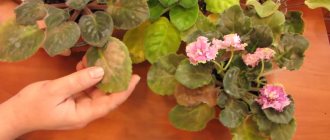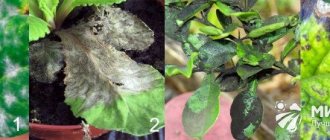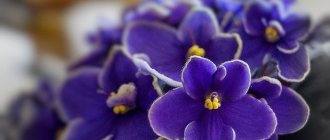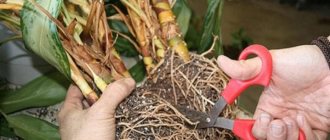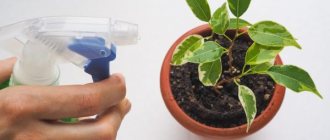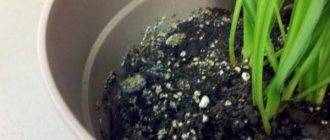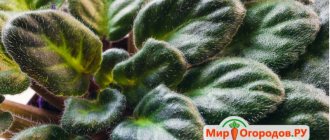Seeing the Uzambara violet, no one will remain indifferent: its elegant flowers of various shades can decorate any home. You need to learn a lot of subtleties and features of the content in order to grow a healthy flower on your windowsill. To prevent tender plants from withering and dying, arm yourself with knowledge about violet diseases with photographs and their treatment.
Signs of plant diseases
Any change in the appearance of Saintpaulia for the worse may be associated with physiological or infectious diseases. Physiological changes depend on incorrect agricultural practices; infectious ones are introduced next if the plant is weakened. A signal that you should look for the cause of the plant’s discomfort is the condition and position of the rosette of leaves. What to do if violet leaves turn yellow?
The correct position of the leaves is horizontal. The leaves do not rise and create a beautiful rosette, in the center of which there is a head of flowers. On a non-flowering Saintpaulia, the leaves are also arranged horizontally.
Physiological changes and their signs
Reasons for the yellowness of violet leaves:
- incorrect placement;
- improper watering and fertilizing;
- substrate requirements are not met;
- natural death of the lower leaves.
The first cause of all troubles may be the acquisition of a plant or cutting with ready-made problems. Therefore, the leaf for rooting should be taken from a healthy plant without the slightest defect and not from the lower tier of the rosette. The purchased plant must undergo a two-week quarantine. This means that the plant is not placed in the collection, it is kept separately and its condition is monitored. Diseases or insect pests will be detected during this time, and the entire collection will avoid infection.
Yellowing of the leaves on the lower tier may mean that the violet is old and has not been replanted for a long time. There is not enough food, and it is distributed to flowers and young leaves. The reason why violet leaves turn yellow may be a lack of potassium and nitrogen. The same result is possible if the earth has lost acidity; elements in an alkaline environment do not pass into a soluble form. The best way to correct the situation may be to replant the flower and replace the soil or water it with slightly acidic water.
However, the cause may be discoloration of leaves in bright light, and not just sunlight. Violets on racks under artificial lighting are also harmful due to excessive lighting. There is a special film that can be glued to window glass or cover plants using accessible methods. Violets with dark leaves are more resistant to excessive light.
The leaf blade may turn yellow when touched to cold glass in winter, when watered with cold water or abundantly. Saintpaulias love moist air, but this is achieved by placing a container of water or damp moss nearby. Is it possible to spray violets? No, this will not increase humidity, but it will ruin the appearance of Saintpaulia. The leaves do not like such moisture. Caring for them involves washing them with soapy water in the shower and drying them in the bathroom once a quarter. A flower with droplets of water will become a focal point for the sun's rays, and the leaf will get burned, an unsightly brown spot.
If the plant is exposed to a draft, this may cause pale or bronzed leaves. Both low and high temperatures have negative consequences for the plant. At temperatures above 25 degrees, the flower plate becomes discolored.
Yellow cut leaves can be used for cuttings. If the corolla is cut off at the bottom and the trunk is exposed, then you should wrap it in moss and moisten it. As a result, roots will appear. The plant goes deeper and receives additional nutrition.
Violet senses insufficient light
All plants need light, since without it photosynthesis does not occur. As soon as you notice that the flowers and leaves on your violet have become pale, keep in mind that the violet is not getting enough sunlight.
In case of insufficient lighting, you can use artificial supplementary lighting. For these purposes, use fluorescent lamps. This product is economical, does not overheat, and its light does not cause burns on the leaves.
Place containers with flowers on windows located in the northern and eastern parts of the house. For the crop, it is necessary to create shade so that burns do not appear on the leaves and the buds do not become paler.
Factors that cause violet leaves to turn yellow
Changes in the appearance of the plant that are not associated with natural processes indicate that the plant is not comfortable enough, that is, the cause of yellowing foliage may be disease, the appearance of harmful insects, or (and this is the most common reason) improper care.
If the problem is a disease or pests, then you will have to use special drugs to solve the problem. If it’s about caring for the plant, then you need to analyze all your actions and understand where the mistake was made.
High air temperature
It just so happens that most often we place plants on the windowsill, without thinking about how bright sunlight and radiators affect the plants. If your windows face the sunny side, then the violets on the windowsill will be uncomfortable, since they do not tolerate direct sunlight. Gradually all the leaves burn out and die, and the soil dries out very quickly.
This is interesting: Where does sphagnum moss grow and what does it look like (photo)?
The best place for a violet would be near a window, but not on a windowsill. The plant must be protected not only from direct sunlight, but also from heating devices. On the other hand, if the windows of your apartment face north, then the violets can be left on the windowsill, but you should still control the heating devices so that the soil in the pot does not dry out.
If drying out of the earthen coma could not be avoided, then resuscitation measures should be carried out - place the flower pot with violet for 30-40 minutes in a container with settled water at room temperature, this time is enough for the earth to be completely saturated with moisture. Over-watering will not occur, because with such watering the flower consumes exactly as much liquid as it needs. After this, place the plant in a more comfortable place where it will not be too hot and where there is no direct rays of the sun.
Lack of lighting
The opposite problem is that with a lack of lighting, the roots can begin to rot, soil moisture increases and the violets begin to fade. They should be given enough light and moved closer to the windows.
If the shoots and leaves turn yellow, you can try to move the pot to a more illuminated place, loosen the soil, but so as not to damage the lower shoots. This will saturate the roots with oxygen, allowing the plant to recover and begin to feed.
Excessively humid air
Violet leaves also turn yellow because the air in the room may be too humid. The flower is very delicate, so too much humidity, as well as a lack of it in the air, can have a bad effect on growth and flowering. If you notice that spots have appeared on the leaves and the soil is not drying well, you need to check how much moisture there is around the flowers. Another indicator of high humidity can be mold that appears on the soil. Sometimes the roots of plants become lighter. This means a lack of oxygen and nutrients. Try to monitor the level of humidity in the pots and regulate indoor watering of all flowers, ventilate the room more often, try to loosen the soil well, but so as not to catch the lower edge of the leaves.
Indoor violet leaves turn yellow due to poor soil quality
Different plants require different soil. Some prefer a higher level of acidity, while others, on the contrary, feel best in calcareous soil. Now in flower shops you can choose any soil without the hassle of preparing the soil mixture yourself.
Besides. If you collect and breed violets, you can additionally purchase indicator paper, with which you will monitor the quality of the soil. By placing such an indicator in the water after watering and seeing a blue color, you can assume that everything is in order - the bud remains alkaline. But the pink color indicates an increase in acidity levels.
Violets are planted in small flower pots; the soil is depleted quite quickly, so the plants must be replanted annually. If you prefer to replant plants not in store-bought soil, but in garden soil, then for violets, collect soil under a birch or linden tree, add just a little ash or crushed chalk to it. Thus, you will get a soil that is as close as possible to what is sold in flower shops.
It is necessary to make a composition suitable for the plant
Baking powder must be added to any prepared mixture. But you can prepare soil that will be more suitable for plants. The first option is the simplest: peat and baking powder, which can be coarse river sand or perlite. But there are other options.
The first version of the soil mixture for violets:
- soil + peat 50%;
- perlite 20%;
- moss 20%;
- nutrient soil + charcoal 10%.
Second option:
- nutrient soil 70%;
- moss 10%;
- perlite 10%;
- charcoal 10%.
Third option:
- peat and nutrient soil 3:1;
- perlite;
- charcoal.
Important! All components of any soil mixture must be sterilized before planting a plant in it. This can be done using a solution of potassium permanganate or any other disinfectant.
In addition to the main components, dolomite flour, eggshells, compost, river sand, and pine soil can be added to any type of substrate.
Excess or lack of fertilizing
Proper nutrition is important for plants. Too little or too little fertilizer can be harmful. Violet loves the presence of the right nutrients in the soil. It is better to fertilize with nitrogen or phosphorus fertilizers. The former ensure good growth and strengthening of the root system, and the latter provide lush, beautiful and bright flowering.
Why do the leaves turn yellow? The first thing that can have a bad effect is a lack of nitrogen in the soil. If there is a lack of nitrogen fertilizers, this is immediately reflected in the leaves on which yellowness appears. Usually the process begins at the edge, after which all the leaves turn yellow.
In any case, indoor plants need to be fertilized correctly. Mineral and organic fertilizers are alternated. Violets are cultivated in summer, spring and autumn. Food is given every two weeks, which helps the flowers not turn yellow. In summer, you can feed more often, but it is important not to overdo it. In winter, the growth and flowering processes in violets slow down, so you need to feed them about once a month.
This is interesting: How to care for hippeastrum after flowering
Overmoistening of the soil is the reason why violet leaves turn yellow
All plants do not respond very well to waterlogging of an earthen clod, but violets perceive it especially painfully. In this case, the unfavorable process begins near the roots and moves along the stems to the base of the leaves; the plant may die literally before your eyes.
This also contributes to the appearance of pests and the development of fungal infections, so the plant must be urgently replanted, changing not only the soil, but also the flower pot. After this, you need to adjust the watering regime so that a similar situation does not happen again. For violets, it is recommended to use drip or “wick” watering, but the best solution would still be to water in a tray - this way the plant can absorb as much moisture as it needs.
Harmful insects
The appearance of yellow spots on the leaves indicates the activity of harmful insects. Examine the back of the leaves - most likely you will find brown spots on it, which are greenhouse thrips that lay larvae on the leaves of violets.
The affected plant must be immediately isolated from the rest and the necessary measures must be taken to destroy pests using insecticides, tobacco or pyrethrum.
Infectious diseases of violets
Infectious diseases include those that invade a weakened plant. Therefore, the cause of the disease is always improper care. In order to protect Saintpaulia from diseases, you should first of all not bring infection with new plants. Quarantine serves as a warning. The plant can be weakened by:
- non-compliance with thermal conditions;
- improper watering of plants:
- drafts, cold damp corner where the plant was placed.
Under such conditions, rot appears on the stems or roots of the violet, areas where late blight can penetrate. This is one of the most dangerous infectious diseases of Saintpaulia when temperature and humidity are not maintained. The causative agent of the disease is transmitted through the soil. Therefore, it is important to disinfect all purchased and homemade soil.
Another disease that can destroy all violets in a short time is called powdery mildew, which begins as a harmless dusty white coating and ends with the death of the plant. Powdery mildew on violets requires prompt treatment. You cannot take layering from such a specimen.
For treatment in the early stages, you can use special drugs such as Topaz or Saprol. As soon as you notice the powdery coating, cover the plant with sulfur powder, seal it tightly with a bag and create a temperature of 25 0 to kill the mycelium. You can spray it using a suspension of soda and laundry soap. If powdery mildew on a violet is severe, destroy the plant and carry out preventive treatment for the remaining inhabitants of the window sill.
The difference between infectious rot is that it spreads to all plants in cramped conditions. Non-infectious diseases can destroy one plant due to improper care.
What causes the edges of leaves to turn yellow?
These symptoms indicate soil depletion, causing your plant to lack nutrients. Perhaps it's time to replant the violet, or (if you replanted the plant not so long ago) add fresh topsoil and carry out unscheduled fertilizing.
Add soil very carefully so as not to harm the fragile leaves and stems of the plant. Feeding should be done with special compounds that are suitable specifically for violets (we talked about this earlier) and strictly follow the recommended dosage. With heavy watering, the soil can be washed out of the pot, which leads to rapid depletion of the soil and a deterioration in the health and appearance of the plant. This is another reason to water violets through the pan.
Rehabilitation after transplant
The transplanted Saintpaulia should not be watered immediately. It should be covered with a bag and placed in a warm place for a couple of weeks. After this, the bag is removed and moderate watering gradually begins.
If problems arise with the leaves, it means that the roots have not yet been able to fully grow and cannot allow the flower to get enough water. Then the greenhouse returns for a few more days.
Also, flower stalks should not be allowed to appear during the rehabilitation period until the roots are fully formed, otherwise the violet will not have enough strength to form vital systems.
Transplanting violets
The leaves are brightening. What is the reason?
Why do babies' leaves turn lighter?
It's like the pigment is leaving. Overfilling and underfilling are excluded. Overexposure too, rather on the contrary, they stand on a shelf with one 24 w lamp, daylight also comes in throughout the day, but from the side. Greenfall soil + vermiculite + perlite. I fertilized it only a couple of times with a low concentration of violet product. What could be the reason?
Marusya, I would venture a guess
Marusya, I would venture to suggest that this is still overexposure, in the sense that the children are standing very close to the lamp and for a long period of time (even if the lamp power is low, like yours), there may also be a problem in the duration of illumination (more than 10 hours), the pigment of the leaves It will recover (but slowly) if you move it further away from the lamp (distance 15-25 cm), but here again you will need to add lamp power to 36 W, you can try to reduce the duration of the glow. All of the above, from my own experience, there was the same picture.
I also think it’s overexposure, U
I also think it’s overexposure. My starters and kids behave the same way. It happens that if a leaf touches a leaf, then the surface not blocked by another leaf is light, but under the leaf is dark. In the morning, look, some are a little darker. Then the lamps are turned on and by the end of the day (I agree with Yulia) more than 10 hours later, the leaves take on the same appearance as in 3 photos. (for me personally)
I had this situation, I
I had the same situation, I also thought it was overexposed! But I noticed that the neighboring bushes, one by one, also began to lighten. I thought it was clearly a fungus! And then on one flower I saw powdery mildew on the sepals. I decided to spray everything with TOPAZ. Spent all day. The surprising thing is that the next morning there was not a single light spot left on the flowers. I will be glad if my experience helps someone!
This is what my poor things looked like! Agree, it doesn’t look like powdery mildew!
Marusya, I agree with Yulia and
Marusya, I agree with Yulia and Sveta regarding overexposure
, although I can’t name a specific reason with 100% certainty, what is to blame for this “burnout” of green and the formation of dark pigment in the areas of the leaf plate between the veins (photo 3 above) - either the lamp hangs too low, or the daylight hours are too long, here It is necessary to find a solution by trial and error.
Definitely, but not powdery mildew. It, of course, can accompany any problem, but its signs are too obvious (you can see the photo on the “Ukraine Saint Paul” Forum in the topic “Powdery Mildew”) - from small round spots, as if sprinkled with white flour, to large areas of damage in advanced cases.
I wrote that it is possible
I wrote that it might be some kind of fungus. The point is that after treatment, the spots disappeared the next day! It is a fact! I just assumed, because... I clearly saw the flour on the flower. I can’t explain what actually happened. But there are no more stains! I want to help! Try treating a couple of bushes. It's just interesting!
Tati, I wouldn't recommend it
Tati, I would not advise Marusya to treat plants (specifically those shown in her photographs), because it is not worth using chemicals at home unless necessary.
Perhaps you had powdery mildew against the backdrop of overexposure, which is also visible in your photo, and it is not surprising that in the morning the color of the leaves was restored, as Svetlana wrote in the comment above.
I had to observe such faded leaves both on a rack, which is illuminated until late at night, and on a loggia in the summer, when it is light for 18 hours. In this case, I cover the windows on the loggia with white covering material, which I remove only on cloudy days.
Thank you very much for your advice.
Thank you very much for your advice. All shelves are 80*30 cm, on this one there is one 24w lamp, the distance to the flowers is 30 cm. And yes, there really is a lot of light, about 12-13 hours. There are two lamps on the bottom shelf, they light the same time, I turn everything off at the same time, but there are very large violets there, about to bloom. For flowering, it seems like there should be 14 hours of daylight, or not? Do adults and children probably have different needs for light? Therefore, with the same duration of illumination, some feel normal, while others brighten.
Hello! I decided not to
I decided not to create a new topic, but to write here, because... I have a similar question.
The leaves of an adult Saintpaulia (Vince's choice variety) have lightened, approximately the lower two layers, although they themselves, according to the variety, are light green, but here they practically began to discolor, almost turn yellow. I'm posting a photo:
This is in normal condition:
Hello Lala! yours
Hello Lala! Your violet urgently needs a transplant. All yellowed or browned leaves will need to be torn off. The yellow color of the leaves indicates a lack of minerals, chlorosis has begun. After replanting, the new grown leaves will be fine. Here is a photo of my violet:
This variety has light leaves, so the outermost row is always lighter than the others. And if after flowering the leaves begin to rapidly turn yellow, then only new soil will save you. In my photo you can also see the light leaves from the first row.
Olga, thanks for the answer.
Olga , thanks for the answer. I’ll do the replanting and at the same time feed it with fertilizers. I really love this violet for its beautiful and abundant flowering.
Good evening. Accept me,
Please accept me into your company.
I also have a similar issue. Tell me, please, what to do?
Preface. There were mature violets that bloomed profusely and there were starters. Midges appeared, began to fight them, sprayed dichlorvos on the flying ones, treated the ground with Grom2, watered them with a weak solution of potassium permanganate, stuck in matches just in case. And soon the leaves of adult violets became stained and they lost turgor. I assumed that it was flooded, but I was surprised by this since I grow violets from leaves and have never flooded them. I replanted it and things seemed to be getting better.
BUT. another problem appeared.
The tops of the starters' heads began to become very light, on almost all young children. and on some leaves there were stains and veins appeared. Before I had time to survive one misfortune, another appeared. I'm going crazy, help. Purchased special soil for Saintpaulias, plus perlite and plus vermuculite, everything by eye. and one more thing - I have a south window, during the day I lower the roller blinds so that there are no burns.
Amina, I even find it difficult
Amina, I find it difficult to even name the specific reason for the appearance of your violets.
In the first photo, in addition to the lightening of the rosette, dark spots are visible near the edges of the leaves. This may be a sign of toxicosis, the result of poisoning.
There is no need to spray dichlorvos, put matches in the soil and use Thunder-2 against midges: this drug is based on Diazinon, it is quite toxic. Buy from midges for 10 rubles. sticky tape “for flies” and attach it above the pots with plants, in a matter of days they will stick and will not bother you. Either the soil is too poor, or simply old, used up (you can also buy this, even in a new package, even if it is “for Saintpaulias”). It also seemed that the substrate was very wet (which is what leads to the appearance of midges), dense, although you write that you added perlite and vermiculite. I wouldn’t even be surprised if I saw that there were no holes in the bottom of the pots, it just felt like there was stagnation of water and the roots weren’t breathing. Violets can also turn pale due to excessive light, but in your case this does not seem to be the root cause.
What else can happen to leaves if not cared for properly?
Improper care is harmful to violets, as well as to any other indoor plants. The results of such care may be:
- with a lack of light, new leaves become lighter and smaller, the petioles become elongated, and the edges of the leaves bend upward;
- increased acidity or excessive salinity of the soil leads to curling of leaf plates, the same problem occurs with a lack of nitrogen or overwatering;
- light spots on the leaves or their tips hint to the grower that the flower is watered with too cold water or is suffering from sunburn;
- with the development of root rot, wilting appears and the color of the leaves is lost;
- gray rot provokes a process in which the leaves may become covered with a gray coating;
- late blight is manifested by the presence of brownish, brown spots on violet leaves, turgor is lost;
- due to non-compliance with the temperature regime, rust may appear on the plant, characterized by unpleasant rusty tubercles and dots on the leaves and cuttings;
- with excessive watering and hypothermia, black rot may develop on the violet, the leaves will darken and turn black.
This is interesting: Dracaena Sandera: caring for the plant at home, photo
Violets are quite whimsical plants, which will not be so easy for an inexperienced gardener to cope with.
Why do the leaves become covered with a white coating like flour?
White bloom on violets is common, since the disease that affects the plant is very common. A coating appears on the leaves, which from a distance looks like flour sprinkled on greens. This is powdery mildew. Reasons for its appearance:
- high indoor humidity;
- incorrect temperature in the room;
- excessive watering;
- poor care of indoor flowers;
- the presence of infected plants within a radius of several meters. Even touching edges can transmit the disease to a healthy specimen.
Powdery mildew
Note! First, plaque covers the lower tiers, so it is sometimes difficult to identify the problem in time.
Treatment options
By changes in its appearance, the violet signals its poor condition. If the leaves begin to dry around the edges, then there is a lack of compliance with the rules for caring for these delicate flowers . To help the plant and prevent its death, it is necessary to take measures to improve agricultural technology as soon as possible:
- adjust the watering regime. The frequency of watering should be selected depending on the time of year, room temperature and the individual characteristics of each plant. The problem with individual selection can be solved by using pots with automatic watering or switching plants to wick watering;
- water with soft water. Hard tap water should be left to stand for at least 24 hours. Flower growers living outside the city can use rain or melt water for irrigation;
- monitor air humidity. As necessary, the air should be humidified by possible means;
- Fertilize regularly. Depending on the season and growth phase, violets require different nutrients, macro and microelements. It is necessary to systematically fertilize or transplant plants into a new nutrient substrate.
How to correct errors in care?
If the violet has pale yellow leaves, it is necessary to analyze all possible errors in care:
- plant location. Perhaps it suffers from direct sunlight or, conversely, from a lack of light. In this case, it is enough to shade the violet or move it to another window;
- temperature in the room where the flower is kept. If it is too high, the air should be cooled and humidified;
- waterlogging or drying out of an earthen coma . It is necessary to establish a watering regime, be sure to use drainage when planting, and use pots with drainage holes;
- compacted soil . To prevent compaction of the soil in the flower pot, it is necessary to use a light, breathable soil mixture for Saintpaulias when planting. If the soil mixture is compiled independently, then the presence of a leavening agent is required: vermiculite, perlite, high-moor peat;
- soil acidity . To prevent leaching, water for irrigation is used that has been settled or filtered. In winter, melted snow can be used. Knowing the acidity of the soil, you can regulate it. To increase it, peat is added, to decrease it, dolomite flour or wood ash is added;
- lack of nutrition . Lightening of the platinum leaf indicates a lack of nitrogen and potassium. But mineral compounds are poorly absorbed individually. A weakened plant needs the entire complex of minerals and trace elements. For emergency assistance, liquid mineral fertilizers are used.
Use complex fertilizers.
Proper care
Why do geranium leaves turn yellow at home - causes and treatment
Proper care of Saintpaulias is the key to success. If you follow all the recommendations of professionals, you can be sure that the flower will grow and develop.
Lush violets
Basic provisions that must be observed at different stages of flower development
- At the very beginning, after purchasing a violet, it must be quarantined for two weeks in a separate room.
- At the stage of the beginning of vegetative development after a period of rest, fertilizing with nitrogenous fertilizers is necessary.
- During the period of bud formation and flowering, potassium-phosphorus fertilizers will come to the rescue.
- During the flowering period, it is necessary to remove fading buds and flowers.
Regardless of the stage of development, wick watering is recommended for all violets. Fertilizers are also added to the soil in the same way.
Basics for caring for violets
For inexperienced gardeners, it may seem that as soon as a violet’s leaves turn yellow, it needs urgent treatment. For this purpose, chemicals are most often used - fungicides. But the yellowing of plant leaves is not always associated with a disease; most often the problem is due to improper care.
Exhibition of violets
Rules for caring for Saintpaulias:
- The plant should be protected from direct sunlight, otherwise the leaves will first begin to dry out and then may even fall off, resulting in serious sunburn. For violets, partial shade or shade is preferable.
- Proper selection of soil is also of great importance for the flower. When replanting, be sure to check whether the plant feels good in its new location. Most often, a special primer for violets is used, which is sold in all flower shops.
- Wick watering. This is something that many gardeners do not know about, but it is this lower type of water delivery that will provide the violets with a sufficient amount of moisture. With top watering, there is a high probability that the plant will rot.
- Regular fertilization during the growing season and throughout the entire flowering period. At the very beginning of the growing season, when the flower comes to life after a short period of dormancy, it needs nitrogenous fertilizers, but as soon as the buds are laid, potassium-phosphorus compounds are added, which will ensure lush and long-lasting flowering. Fertilizers are also applied during watering using the wick method. Complex liquid solutions are simply added to water.
- Change the soil in the pot annually.
Violets also need to periodically tear off the lower leaves and regularly remove dried flowers.
Advice! To make the violet more fluffy, it needs to be periodically turned to the light in different directions.
How to prevent yellow leaves?
It is necessary to pay attention to the leaves of the flower when purchasing it. Often we do not notice the small spots of yellow or brown color and make a purchase in the confidence that the plant is healthy. But at home, the beginnings of the disease develop, and troubles begin.
To prevent the plant from getting sick, plant it correctly from the beginning. The pot must be new. But even if it is old, wash it before planting and then disinfect it. This will guarantee that the diseases of the old flower will not transfer to the plant you want to replant. Also, always use new compost. It is better if it is bought in a store. After all, such products undergo quality control and certainly do not contain fungi or pests. Well, the land that you can collect in the garden or in the forest is not immune from this.
Try not to place violets next to other plants, let them have their own place. This will prevent the transfer of diseases and pests from one flower to another.
Consider the characteristics of different varieties of violets. Plants with dark leaves like less light than those with naturally light leaves. Use this information when placing your flowerpot.
Adjust the watering and fertilizing regime to suit certain times of the year. In winter, the flower's needs decrease, and in spring, during the period of active growth, on the contrary, they increase.
Watch also the video, which tells about some of the secrets of growing violets.
Preventive measures
Still, it is better to prevent a problem than to fix it later.
An excellent preventative measure would be regular feeding:
- 1 time every 2 weeks – in spring and autumn;
- Once every 30 days - in the autumn-winter period.
Some gardeners recommend periodically carefully replanting the plant , partially or completely replacing the soil mixture.
also recommended to acidify water for irrigation with vinegar or citric acid to soften it.
What type of violet should I change to if all else fails?
If no methods help, and the leaves still turn yellow and become pale, it is better to change the variety of violet. Experienced flower growers advise purchasing a hybrid variety that blooms almost all year round or, conversely, produces buds only for a short period of time. It depends on what varieties you can't grow.
Growing violets at home is not difficult if you follow all the rules for caring for them. But it is better for an inexperienced gardener to purchase a more modern hybrid variety, which is less demanding in care. Nowadays, different varieties have been developed that are adapted to different conditions.
How to protect a plant from negative environmental factors?
In order for extreme environmental conditions to have less impact on the development, growth and flowering of violets, it is necessary to adhere to optimal conditions and agricultural techniques for growing Saintpaulia:
- adjust the intensity and duration of lighting;
- adjust the hydration of the earthen coma. Do not overwater or dry out the plant;
- observe the temperature regime. Avoid drafts, sudden temperature changes, and heat;
- maintain air humidity at least at 30-40%;
- replant violets in time in fresh loose soil in small pots;
- do not overfeed with fertilizers. It is better to underfeed Saintpaulia a little than to overfeed it;
- Maintain plant hygiene by washing it periodically in the shower.
Unsuitable soil acidity
Crops do well in neutral or slightly acidic soil. If the acidity is high, the leaves immediately turn yellow and the flowers fade.
The land needs to be fertilized. Peat must be added to soil with low acidity, and wood ash must be added to soil with high acidity. Soft and breathable soil is considered ideal for violets.
Feeding violets
